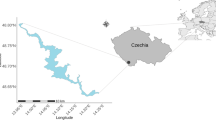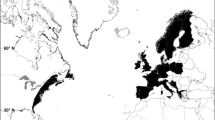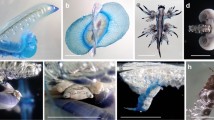Abstract
Population dynamics of a Gari solida (Gray, 1828) population from Bahía Independencia, Peru (14°S) was studied between November 1989 and February 1995 (except for 1991) in order to investigate the effects of the climate phenomenon El Niño/Southern Oscillation (ENSO) which occurred in 1992/93. Results indicate that ENSO had negative effects on gonad production in 1992, when temperatures were very high, and positive effects in 1993, when temperatures were lower, but the warm period lasted longer than in 1992. Higher reproductive output in 1993 was achieved by several spawning events in addition to the normal pattern. Growth rate in 1990 was higher (K=0.495) than in 1993/94 (K=0.346). A possible explanation could be that more energy was allocated to reproduction, and thus less surplus energy remained for growth. The negative effect of ENSO on production in 1992 is indicated by the low P/B ratio (0.298); in all other years P/B was consistently higher (1990: 0.570; 1993: 0.597; 1994: 0.597). From 1990 to 1994 a reduction of mean annual biomass from 189.3 to 14.4 g ash-free dry weight m-2 was also observed which may be related to fishery activities. The consistency of P/B ratio is best explained by the higher somatic production of the smaller individuals remaining after the larger individuals had been removed selectively by fishermen. Based on the results presented in this study and from the literature, a model is proposed depicting how ENSO may negatively affect bivalve populations. Two main factors are mentioned, increased temperature and reduction of assimilated energy.
Similar content being viewed by others
References
Allen KR (1971) Relation between production and biomass. J Fish Res Bd Can 28: 1537–1581
Appeldoorn RS (1987) Modification of a seasonally oscillating growth function for use with mark-recapture data. J Cons int Explor Mer 43: 194–198
Arntz WE (1984) El Niño and Peru: positive aspects. Oceanus 27: 36–39
Arntz WE (1986) The two faces of El Niño 1982–1983. Meeresforsch 31: 1–46
Arntz WE, Brey T, Tarazona J, Robles A (1987) Changes in the structure of a shallow sandy beach community in Peru during an El Niño event. S Afr J mar Sci 5: 645–658
Arntz WE, Fahrbach E (1991) El Niño — Klimaexperiment der Natur. Birkhäuser Verlag, Berlin
Arntz WE, Tarazona J (1989) Effects of El Niño 1982–1983 on benthos, fish and fisheries off the South American Pacific Coast. In: Glynn PW (ed) Global ecological consequences of the 1982–83 El Niño-Southern Oscillation. Elsevier Oceanography Series. Elsevier, New York, pp 323–360
Arntz WE, Tarazona J (1990) El Niño 1982–1983 im Rückblick — was haben wir gelernt? Biologie uns Zeit 53: 1–18
Barber RT, Chávez FP (1986) Ocean variability in relation to living resources during the 1982–83 El Niño. Nature, Lond 319: 279–285
Bertalanffy von L (1938) A quantitative theory of organic growth. Inquiries on growth laws. II. Hum Biol 10 (2): 181–213
Beverton RSH, Holt SJ (1956) A review of methods for estimating mortality rates in exploited fish populations, with special reference to sources on bias in catch sampling. Rapp P-v Réun Cons perm int Explor mer 140: 67–83
Birkett DA, Cook P (1987) Effect of the Benguela temperature anomaly, 1982–1983, on the breeding cycle of Donax serra Röding. In: Payne AIJ, Gulland JA, Brink KH (eds) The Benguela and comparable ecosystem. S Afr J mar Sci 5: 191–196
Carrasco S, Santander H (1987) The El Niño event and its influence on the zooplankton off Peru. J geophys Res 92 (C13): 14405–14410
Clasing E, Brey T, Stead R, Navarro J, Asenico G (1994) Population dynamics of Venus antiqua (Bivalvia: Veneracea) in the Bahía de Yaldad, Isla de Chiloé, southern Chile. J exp mar Biol Ecol 177: 171–186
Crisp DJ (1984) Energy flow measurements. In: Holme NA, McIntyre AD (eds) Methods for the study of marine benthos. Blackwell, London, pp 284–372
Diaz A, Ortlieb L (1992) El fenómeno “El Niño” y los moluscos de la costa peruana. In: Ortlieb L, Macharé J (eds) Paleo ENSO Records int Symposium, extended abstracts. ORSTROM-CONCYTEC, Lima, pp 73–79
Ekman VW (1905) On the influence of the earth's rotation on ocean-currents. Ark Mat Astr Fys 2 (11): 1–53
Etim L, Brey T (1994) Growth, productivity, and significance for fishery of the bivalve Egeria radiata (Donacidae) in the Cross River, Nigeria. Arch Fisch Meeresforschung 42(1): 63–75
Eversole AG (1989) Gametogenesis and spawning in North American clam populations: implications for culture. In: Mauzi JJ, Costagna M (eds) Clam mariculture in North America. Devs Aquacult Fish Sci 19: 75–109
Hoenig JM (1983) Empirical use of longevity data to estimate mortality rates. Fish Bull US 82: 898–903
Illanes JE, Akaboshi S, Uribe E (1985) Efectos de la temperatura en la reproduccin del ostin del norte (Argopecten purpuratus) en la Bahía Tongoy durante el fenmeno El Niño 1982–83. Investigación pesq 32: 167–173
Ishiyama CV, Chávez G (1990) Reproduccin de Gari solida (Veneroida, Psammobiidae). Rev Cienc UNMSM (Lima) 75(1): 52–65
Kinne O (1970) Temperature: animals — invertebrates. In: Kinne O (ed) Marine ecology. Vol. 1. Environmental factors. Wiley Interscience, London, pp 407–514
Loosanoff VL, Miller WS, Smith PB (1951) Growth and setting of larvae of Venus mercenaria in relation to temperature. J mar Res 10: 59–81
Pauly D (1979) Gill size and temperature as governing factors in fish growth: a generalization of von Bertalanffy's growth formula. Ber Inst MeeresKde Kiel 63
Pauly D (1983) Length-converted catch curves. A powerful tool for fisheries research in the tropics. Part I. Fishbyte 1 (2): 9–13
Pauly D (1986) On improving operation and use of the ELEFAN programs. Part II. Improving the estimation of L∞. Fishbyte 4(1): 18–20
Pauly D, Gaschütz G (1979) A simple method for fitting oscillation length growth data, with a program for pocket calculators. Int Counc Explor Sea Comm Meet [Demersal Fish Comm] G: 24
Press WH, Flannery BP, Teukolsky SA, Vetterling WT (1986) Numerical recipes. The art of scientific computing. Cambridge University Press, Cambridge
Read KRH, Cumming KB (1967) Thermal tolerance of the bivalve molluses Modiolus modiolus (L), Mytilus edulis (L) and Brachidontes demissus Dillwyn. Comp Biochem Physiol 22: 149–155
Ryther JH (1969) Photosynthesis and fish production in the sea. Science, NY 166: 72–76
Soenens P (1985) Estudios preliminares sobre el efecto del fenmeno “El Niño” 1982–1983 en comunidades de Aulacomya ater. In: Arntz WE, Landa A, Tarazona J (eds) El Niño — su impacto en la fauna marina. Insituto del mar del Peru, Boletín, Callao, Peru (Volumen Extraordinario), pp 51–53
Somers IF (1988) On a seasonally oscillating growth function. Fishbyte 6(1): 8–11
Tarazona J, Arntz W, Canahuire E (1996) Impact of two El Niño events of different intensity on the hypoxic soft bottom macrobenthos off the central Peruvian coast. Pubbl Staz zool Napoli (I. Har Ecol) 17 (i)
Urban H-J (1992) Ökologie ökonomisch wichtiger Muschelarten im Auftriebssystem der Pazifikküste Lateinamerikas. Dissertation, Universität Bremen, Bremen
Urban H-J (1994a) On the adaptation of six infaunal bivalve species of Chile: differences in morphologh, burrowing depth and substrate preference allow their coexistence. Arch Fisch Meeresforsch 42(2): 183–193
Urban H-J (1994b) Upper temperature tolerance of ten bivalve species off Peru and Chile related to El Niño. Mar Ecol Prog Ser 107(1): 139–145
Urban H-J (in preparation) An example for overfishing of a commercially exploited Gari solida population in Bahía Independencia, Peru (14°S).
Urban H-J, Campos B (1994) Population dynamics of the bivalves Gari solida, Semele solida and Protothaca thaca from a small bay in Chile at 36°S. Mar Ecol Prog Ser 115: 93–102
Wetherall JA (1986) A new method for estimating growth and mortality parameters from length-frequency data. Fishbyte 4(1): 12–14
Warwick RM (1980) Population dynamics and secondary production of benthos. In: Tenore KR, Coull BC (eds) Marine benthic dynamics. University of South Carolina Press, Columbia, pp 1–24
Widdows J (1976) Physiological adaptation of Mytilus edulis to cyclic temperatures. J Comp Physiol 105: 115–128
Wolff M (1985) Fischerei, Ökologie und Populationsdynamik der Pilgermuschel Argopecten purpuratus (L.) im Fischereigebiet von Pisco (Peru) unter dem Einfluß des El Niño 1982–1983. Dissertation, Christian-Albrecht-Universität, Kiel
Wolff M (1987) Population dynamics of the Peruvian scallop Argopecten purpuratus during the El Niño phenomena of 1983. Can J Fish aquat Sciences 44: 1684–1691
Wolff M (1987) Spawning and recruitment in the Peruvian scallop Argopecten purpuratus. Mar Ecol Prog Ser 42: 213–217
Author information
Authors and Affiliations
Additional information
Communicated by O. Kinne, Oldendorf/Luhe
Contribution No. 991 of the Alfred-Wegener-Institut für Polar- und Meeresforschung, Germany
Rights and permissions
About this article
Cite this article
Urban, H.J., Tarazona, J. Effects of El Niño/Southern Oscillation on the population dynamics of a Gari solida population (Bivalvia: Psammobiidae) from Bahía Independencia, Peru. Marine Biology 125, 725–734 (1996). https://doi.org/10.1007/BF00349255
Received:
Accepted:
Issue Date:
DOI: https://doi.org/10.1007/BF00349255




